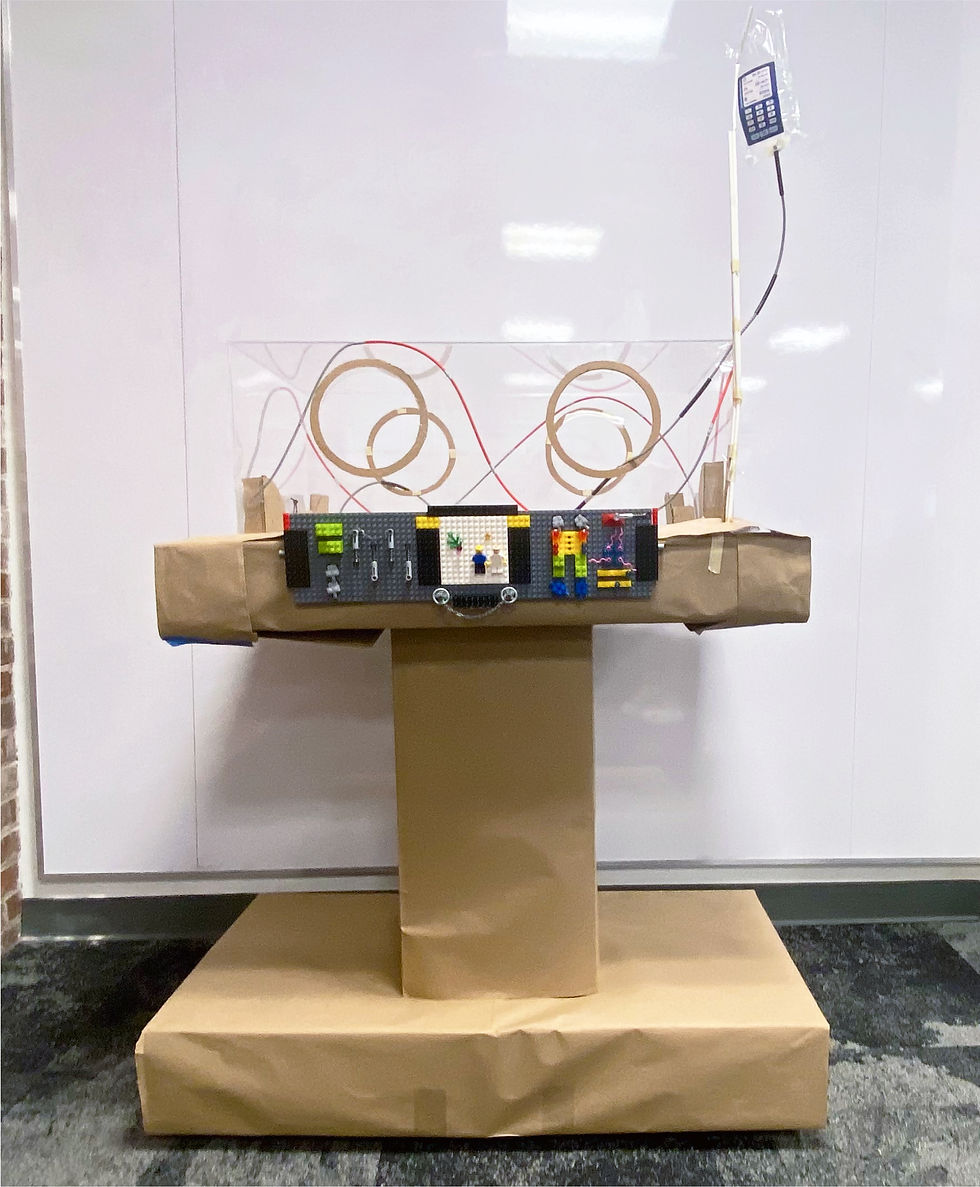
FUTURE OF NICU
Rapidly create and ideate a prototype a NICU by exploring opportunities to reduce mortality of newborn babies.
Group Project(13X)
My Contribution:
Ideation, Rapid LowFi Prototyping
Timeline
f 2023 - March 2023 1 Week
Neonatal Intensive Care Unit
CONCEPT
Ideation
The project was executed by a class of 13 students who were divided into 3 groups. Each group researched, ideated and created a low fidelity prototype of the interventions.




INTERVENTIONS
Mockup

1
2
3
4
Current Problem: Neonatal are sometimes subjected to excessive IV fluid consumption without proper monitoring.
IV Fluids Monitoring & Controller
Future Intervention: The system aids in the continuous or intermittent delivery of fluids and medications to neonates. A screen shows the duration, dose, and rate of fluid delivery which helps in the reduction of medication errors.
1
Current Problem: NICU rooms are loaded with machines and IV stands which are frequent obstacle for hospital staff to walk around the facility safely.
IV Pole
Future Intervention: The IV pole in integrated with the NICU unit, when required can be pulled up easily to hang IV fluid bags. This provides enough floor space for staff to work without any hindrance.
2
Current Problem: The parents cannot see or touch their baby since NICU is an Isolated sterile environment.
Camera
Future Intervention: The camera is connected wirelessly to tablets so that parents can watch their baby and feel comfortable with the distance the treatment.
3
Current Problem: The babies feel uneasy without their mother’s touch which makes them uncomfortable.
Bionic skin cushions
Future Intervention: The bionic skin pad simulates the temperature and texture of real human beings to bring babies a sense of security
4
Current Problem: Also as part of the parent-baby interaction enhancement, lighting is also usually part of a big and heavy structure that can be replaced.
Light Strip
Future Intervention: The light strip can be flashing with a breathing light according to the parent’s activity, visually stimulating the child to interact with the parent.
5
Current Problem: It is hard for nurses or doctors to find a vein in the neonatal due to adipose tissues which results in a lot of pricking.
Vein Detector
Future Intervention: Vein detector with dual wavelength high intensity (LED) light helps to find vein and reduces unnecessary pain for neonatal.
6
Current Problem: The feeding tube contains nutrition (formula or breast milk), which is not provided in a required proportion to neonatal.
Feeding Tube
Future Intervention: The feeding tube with an automated system helps to deliver nutrition (formula or breast milk) efficiently to neonates.
7

5
7
6
Current Problem: Parents can’t interact with the baby when it is not allowed to take him from the unit or remotely.
Interaction Controller
Future Intervention: Available for nurses and parents to operate and enhance the interaction with the child. The monitor in the middle allows video calls between the child and the parents.
12
Current Problem: Babies need to feel their parents voice and smell, but sometimes they are required to stay in the unit for treatment.
Interactive Sensors
Future Intervention: The sensor plays the parent’s voice and emits the parent’s smell. From the auditory and olfactory stimulation so that children have a sense of security from their parents.
11
Current Problem: Infants in incubators lose their connection with their mothers because they’re kept isolated and can’t be touched by anyone other than nurses.
Heartbeat Simulation
Future Intervention: Inside of the incubator a recording of the mothers heartbeat plays. This simulates the sounds of the womb and builds a connection between the mother and her child.
10

9
8

Current Problem: The babies feel uneasy without their mother’s touch which makes them uncomfortable.
Moving Wheels and Lift Tables
Future Intervention: Bottom with wheels for easy movement. The height of the lifting table can be adjusted to facilitate the operation of nurses and doctors.
8
Current Problem: The doctors or nurses are unable to track the amount of nutrients provided through feeding tube.
Feeding Tube Display & Controller
Future Intervention: The display screen will allow nurses or doctors to monitor the flow rate of the liquid as well as track the time. The screen features a large, easy-to-read display, an
intuitive keyboard, an alarm, and a familiar user interface.
9

12
11
10
Project
Challenges
1. Research
Time constraints to build the prototype required us to reduce the time to research significantly. To alleviate this challenge, we contacted medical professionals to understand how NICU is used and the challenges.
2. Coordination
Since the NICU has a lot of parts and features, it was necessary to divide the task to build the prototype in time. The ideated interventions were planned and divided into 3 teams to execute. To assemble the prototype, a design and set of parameters was created to control the scale and dimensions



